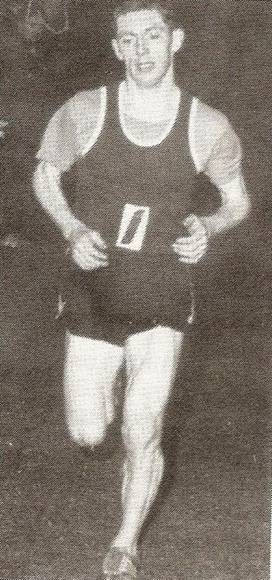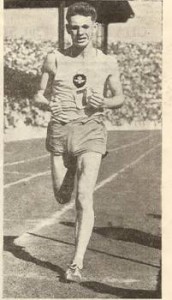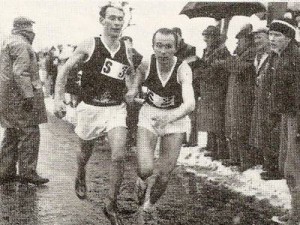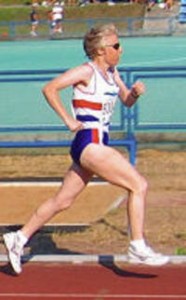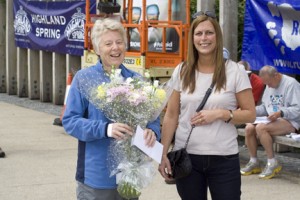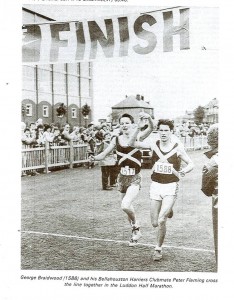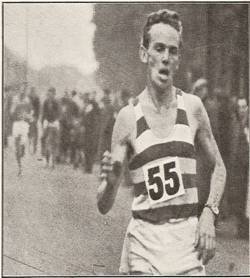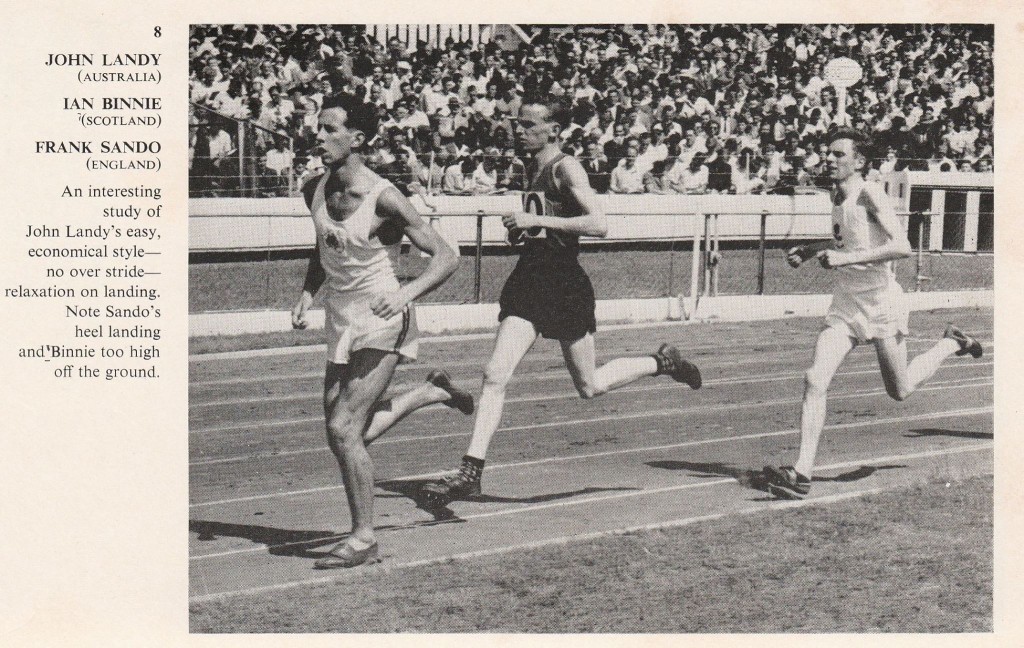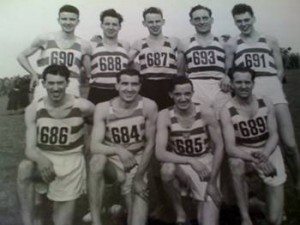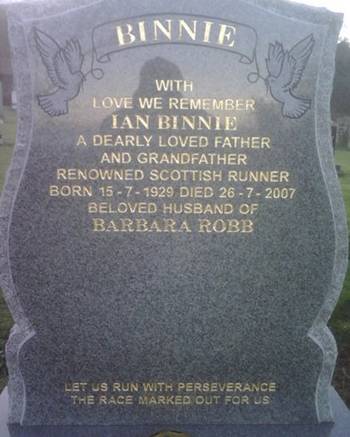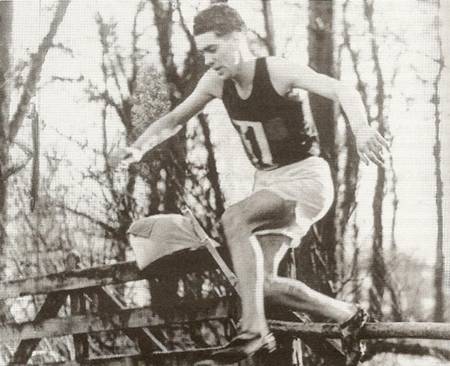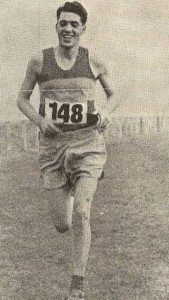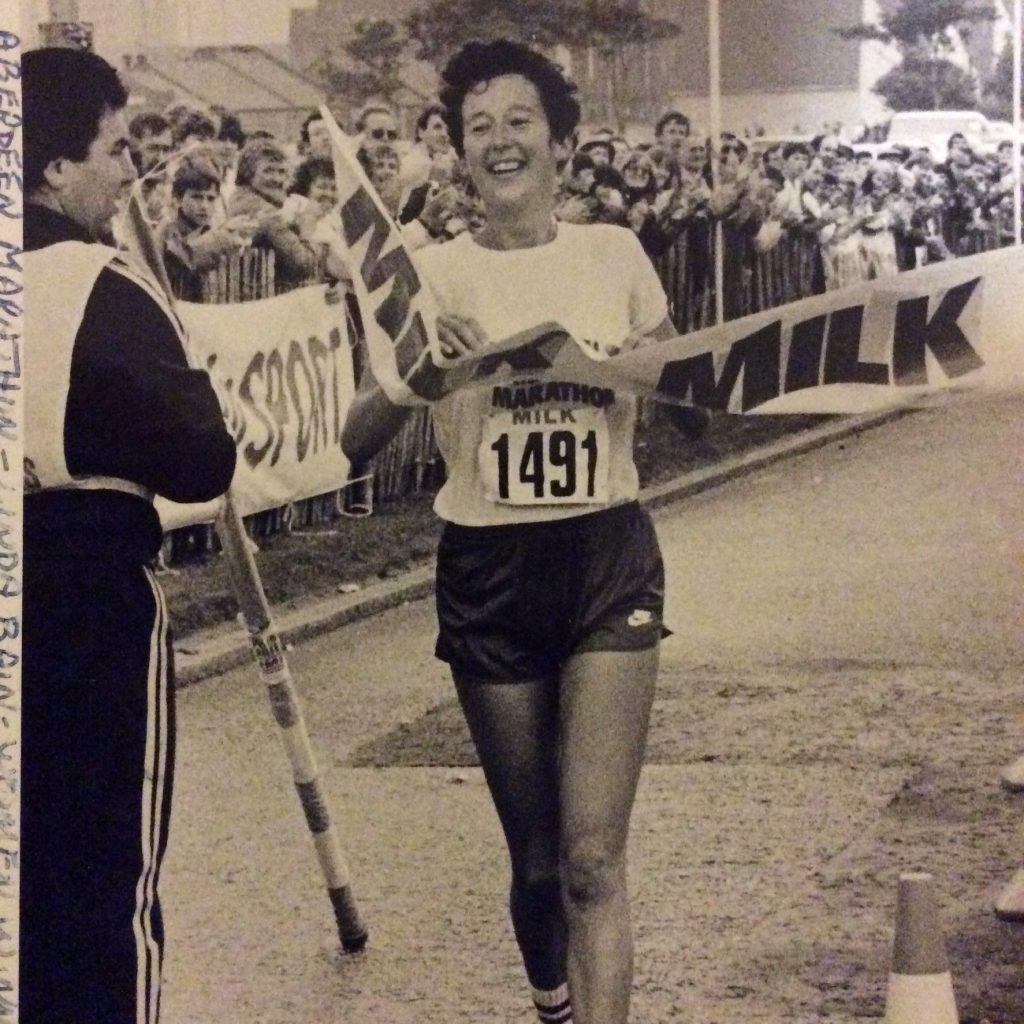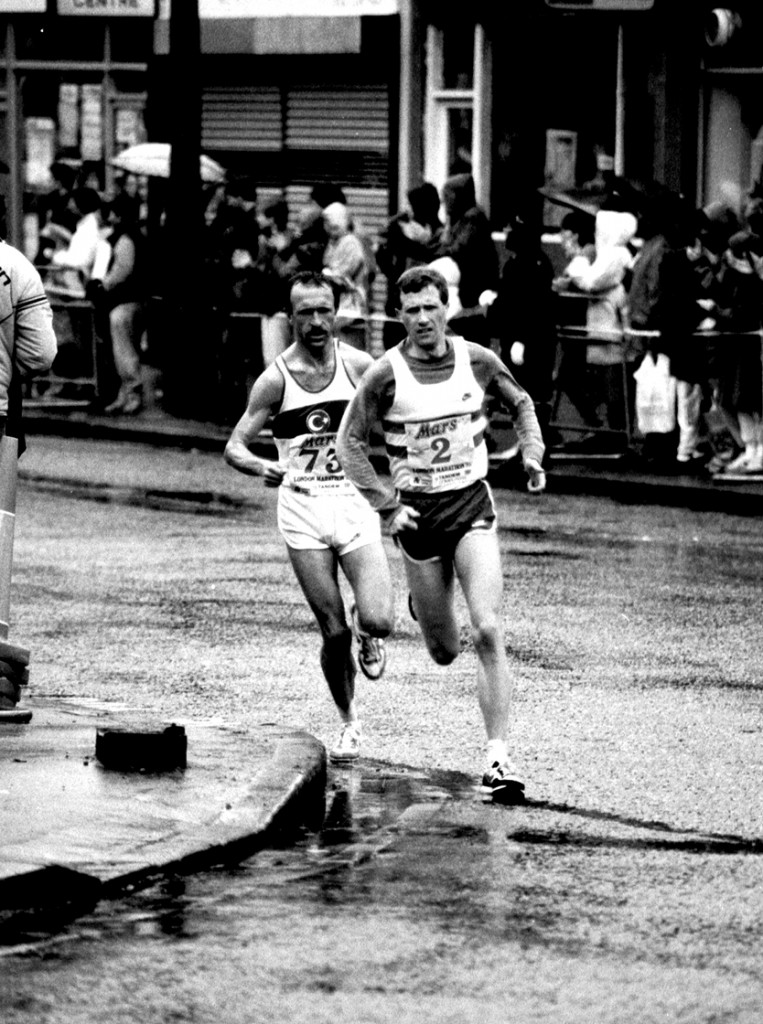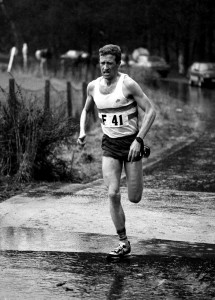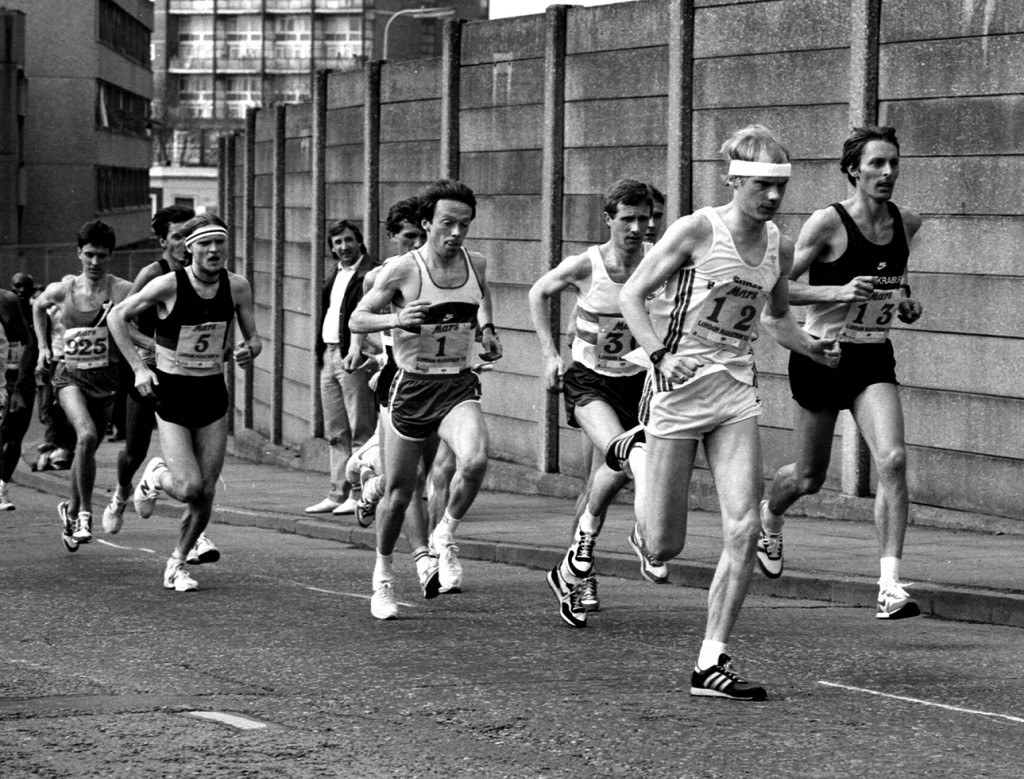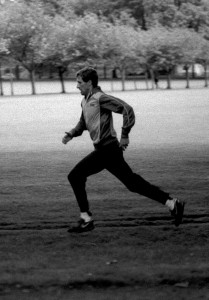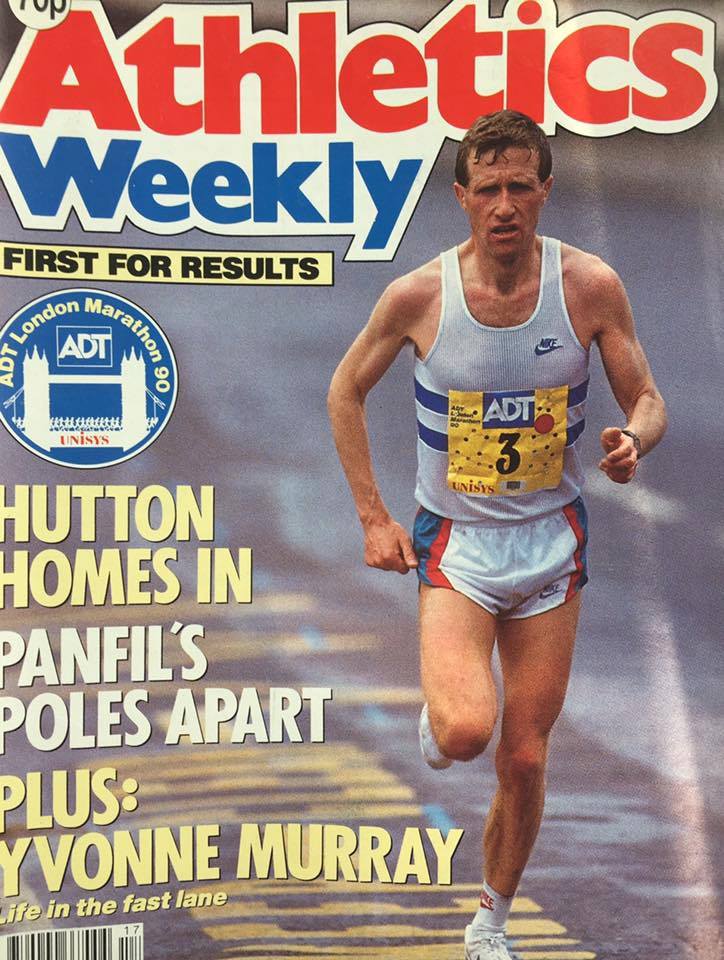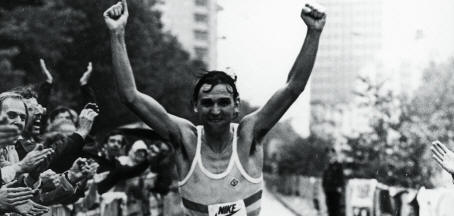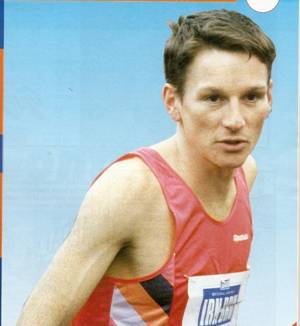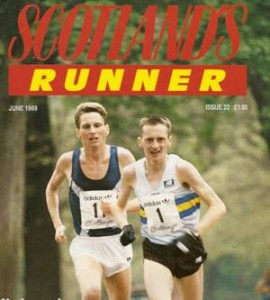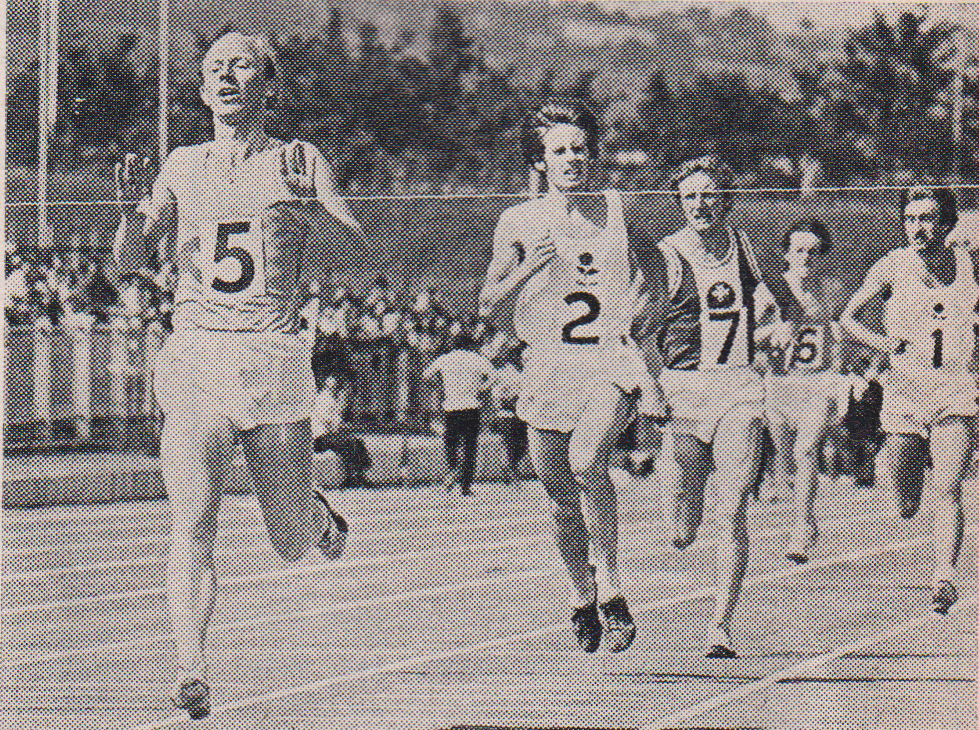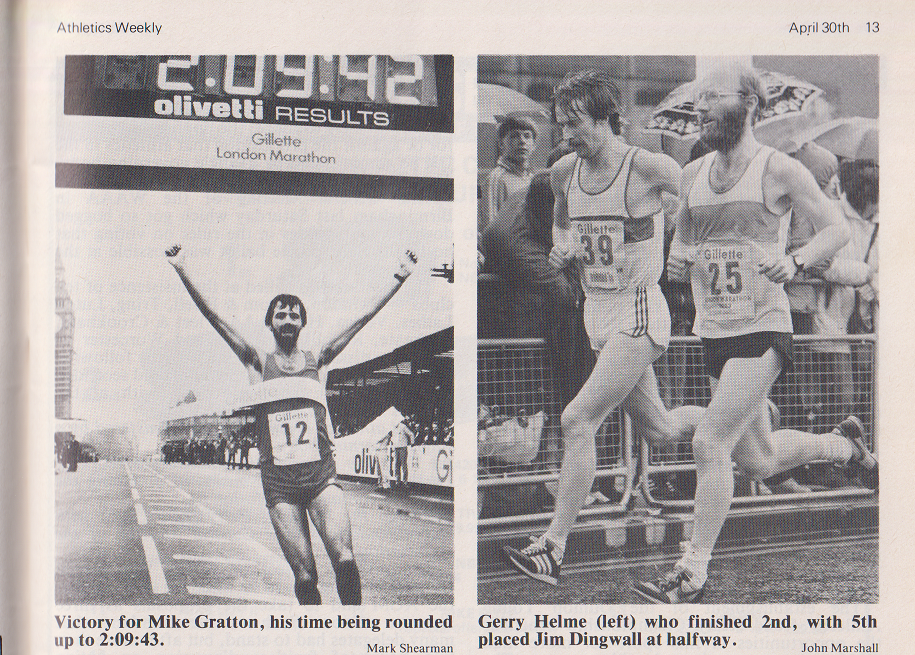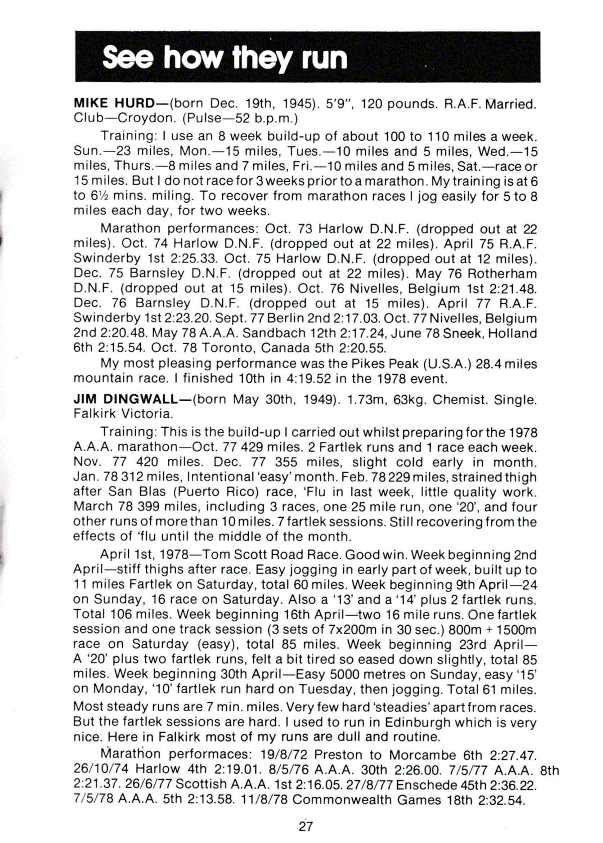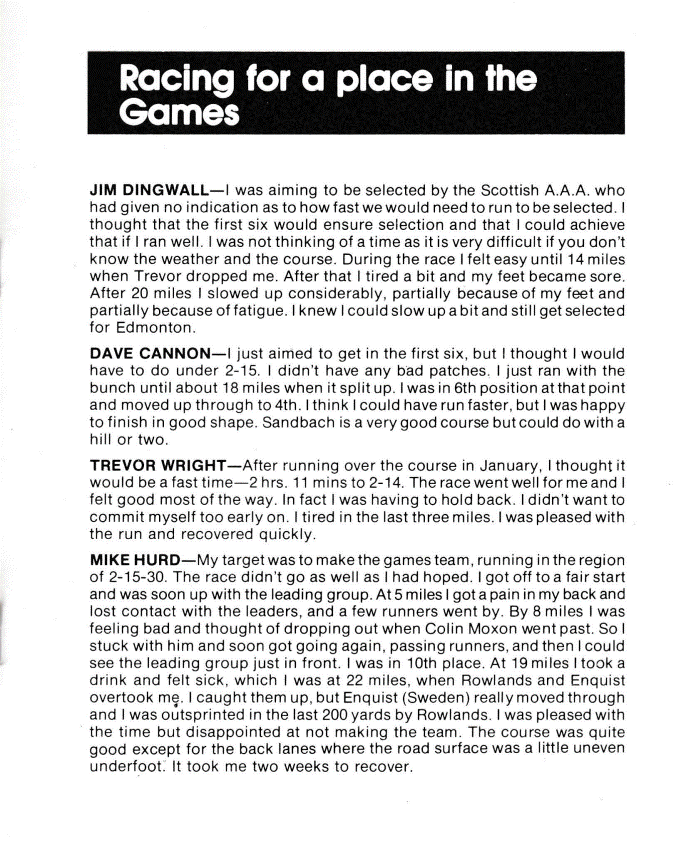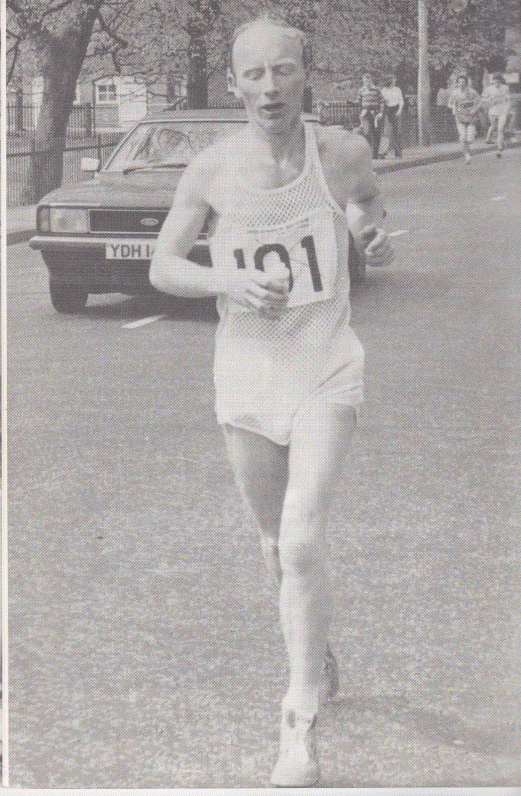Motherwell YMCA Harriers – who had had many good athletes all through their existence – went through a real ‘purple patch in the 1960’s. They won the Edinburgh to Glasgow in 1962, 1963, 1964, second in 1965 and third in 1961 and 1966. They won the National Cross Country Championships in 1961 and were third in 1963 and won the West District Cross Country Championship in 1961, 1962, 1963, 1964, 1965, 1966, 1967 – seven times in all. I haven’t mentioned any of the relays either but it was a quite remarkable spell. They had many good or first class athletes and names like Bert MacKay, John Linaker, Ian McCafferty, Alex Brown (AP Brown) and many others are very well known to all followers of the sport. But the common opinion is that Andy Brown had more than most to do with it. A natural leader he was also captain of the Scottish Cross Country team and was highly regarded by all in the sport whether officials or, especially, by other runners. In this first section we can look at his rise to prominence up to early 1956.
Born on 11th December 1932, he was known on the programmes as AH Brown to distinguish him from his brother Alex. So he was not the first A Brown to run for Motherwell – his father was a good class road and marathon runner and this was picked up by Emmet Farrell in ‘The Scots Athlete’ of August 1952 as follows: “Father and Son Rivalry” There’s a very interesting and friendly rivalry between the two A Browns, Junior and Senior of Motherwell YMCA H. The son is a fairly prolific prize-winner on the track. But his wiry, 47 year old father is not far behind him. He has had several notable wins and places in road races and at Dunoon even managed to gain the scratch award. Even though most of the notable road runners were absent it is still a remarkable feat to beat runners some nearly half his age. That year he had run two marathons and finished in the middle of the field and at the Victoria Park Relays in October they both ran in the same team with Tom Scott and Bryce McRoberts making up the team with Andrew Junior being second fastest, 21 seconds slower than McRoberts. The club had a team in the Edinburgh to Glasgow that year but only one A Brown was in it and I’m assuming that it was Senior who ran the fifth stage but on the Midland Cross-Country Championships it was AH Brown who led the club home with his twenty first place. He was still a Junior though and in the National Junior Cross-Country Championships at Hamilton in 1953 he finished eleventh with his Dad being exactly 100th in the Senior race. Later that year it was AH Brown who turned out for the Edinburgh to Glasgow Relay on the second stage and after taking over from Tom Scott in 17th place he handed over in 15th with the final team position being 18th. He did however run the same time to the second as CD Robertson running for Dundee Hawkhill and they were equal seventh fastest. For an Under 20 runner to do that running so far down the field is indeed commendable. In the National at Hamilton in 1954 he finished third, having been eighth in the Midlands Championship, behind John McLaren (Shotts) who won in 32:42 and Adrian Jackson, a star English runner running for Edinburgh University, in 32:46. Andy’s time was 33:01 and Emmet Farrell had this to say: Surely the best race of the day was on the Junior Championship over 6 miles. The race between McLaren of Shotts and Jackson of Edinburgh was a classic. With incredible grit and courage, McLaren fought off his renowned adversary to win with little to spare. This race was an exhilarating spectacle and while McLaren deserved the spoils of victory – great credit is due to Jackson who moved up to the from from about tenth place. AH Brown of Motherwell YMCA also had a grand race and actually assumed the lead with two miles to go.”
A year later and he was ninth in the 1955 National Cross Country Championships and had his first run for Scotland in the International Cross Country Championships. Colin Shields in the official history of Scottish Cross Country remarked “In the early days of 1955 Andrew Brown won the Beith race having earlier been just nine seconds slower than Bannon in the Midlands Relays. He was showing the benefit of the extra training he received during his National Service in the Royal Air Force and was beginning to display the form which was to gain him twelve international vests in the next fourteen years. An interesting feature of this National was that the Irishman Cyril O’Boyle of Clydesdale Harriers finished in sixth place and the selectors debated whether to include him in the Scottish team. The vote went against him with one of those opposed to O’Boyle’s selection being the Clydesdale Harrier on the selection committee! In the International that year the Scots team disappointed but Andy Brown was fifty second and a counting runner in the event. This was just a year after being third in the Junior Championship.
In the list of Scottish Best performances printed in the ‘Scots Athlete’ in June 1955, he was ranked third in the Three Miles with 14:40.4, a time run in Withdean in May that year. the significance was that although these Best Performance Lists were published every summer every month this was his first appearance in the rankings as published in the ‘Scots Athlete’. By the time new lists were published in August he was second to Ian Binnie with 14:12.6. Before they came to the actual results of the SAAA’s Championships, Emmet Farrell commented – “A Brown Surprise: Ian Binnie retained his 3 and 6 miles titles creditably though not up to the best Binnie standards but Motherwell’s Andy Brown by his second place in both events revealed himself one of the most improved runners in the country. In the 6 miles in particular he gave Binnie some anxious moments till the latter’s extra class prevailed and his time of 30:03 was excellent.” Farrell went on in the same Commentary to report on the AAA’s of England Championships and had this to say: Brilliant too were the 4th places won by Don Gorrie in the 880 yards and Andy Brown in the 6 miles. Gorrie’s time, unofficially assessed at 1:52 compares favourably with the winning time of 1:52.2, as does Brown’s grand 29:35.2 with Norris’s 29:06 in the battle of the heatwave.” The results of the two races at the SAAA were Binnie first in both with 14:18.9 and 29:40.4 and Brown second in 14:31.1 and 30:03.
Came the cross-country season and the ‘Running Commentary’ in the ‘Scots Athlete’ said: “Rise of Andrew Brown. Motherwell’s Andy Brown is surely the most promising and improved runner in Scotland. Starting with his two seconds to Binnie in the Scottish 3 and 6 miles he ran the race of his life in the AAA 6 miles to finish fourth in 29:35.2. He had other great races at various distances subsequently winning several mile handicaps in fast time.”
In the first two races of the winter 1955/56 season he had second fastest time in the Victoria Park Relays of 15:03 – only one solitary second behind Eddie Bannon of Shettleston; he followed this up with fastest time in the Lanarkshire Relays ahead of all the Shettleston runners who filled the first two team places. The picture below is from the Scots Athlete of the time and shows Brown in the RAF running vest.
In the ‘Scots Athlete’ for December 1955 Emmet Farrell was saying that if there were an award not for the best runners of the year but for the most improved in the fashion of the E-G’s most meritorious award, he would have to choose between three runners of whom Brown was one. In the Midlands District Championship that season Brown was second, six seconds behind John McLaren and thirteen ahead of Bannon. In his annual preview of the National for 1956, Emmet Farrell predicted the first three as John McLaren, Andy Brown and then Eddie Bannon. He reckoned that Brown seemed to be reaching his peak at the right time and might even start as a slight favourite before talking about the amazing advance the ‘little Motherwell runner’ had made. (the references to the ‘little’ Motherwell runner seem odd – I don’t remember him as particularly wee: that was Dunky Wright and Harry Fenion!) As for the forecast – well he got one right! The result was a victory for Eddie Bannon with Andy second and Tom Stevenson of Wellpark third. In the International match that followed, Andy Brown finished fiftieth and out of the counting six for the team which was fourth, one point in front of Portugal.
Into the summer of ’56 the Scottish Best Performances at 3rd June had Andy fourth in the Two Miles with 9:23.4 and he had his usual good season culminating in victory in the Scottish Six Miles Championship in 29:47.6 and then being second in the Three Miles the following afternoon in 14:40.6. The second athlete in the six was Pat Moy of the Vale of Leven in 31:10.2 so it was a convincing enough win over a Scottish cross country internationalist. As usual Emmet had something to say in his review of the championships: “Much improved Andy Brown also deserves commendation for his grand Six Miles in the Championships on his versatility.”
Winter 1956/57 began with Andy running 14:56 and picking up eight places on the third stage of the Victoria Park Relays and setting a new course record of 14:56, one second faster than Graham Everett of Shettleston only to see Ian Binnie take it away from him with 14:53 on the final stage! In the Edinburgh to Glasgow Relay in November he ran the sixth stage and pulled his club from fourteenth to twelfth. The final list of Best Performances for 1956 was in the January 1957 issue of the magazine and Andy was second in the Three Miles with 13:56 run at Pitreavie and first on the Six with 29:10.0 run at the White City in July. According to the results as printed he did not run in the National Championships in 1957. But a year later he recorded his only win in the event.
Colin Shields wrote of the Championships in 1958: “Andy Brown (Motherwell YMCA) won his first and only National title over a tough test of strength and stamina in which the course was extended to include the rough countryside between the Hamilton Racecourse and the River Clyde. Brown finished three seconds in front of Graham Everett with newcomer Alastair Wood finishing in third position.” This of course earned selection for the International Cross Country Championship in Wales and Colin reported on it. “The 1958 International Championships, held at Portcanna Field, Cardiff, resulted in the now expected poor performances from Scottish runners. Scottish National Champion Andrew Brown and John McLaren failed even to make the counting six for their country.” (Andy when he won, but Andrew when he failed to count!) In the 1958/59 season the report is from Colin Shields again. “Andy Brown won the Nigel Barge Road Race in 23:02 but met his match in the Midland Championship when miler Graham Everett won the first of three consecutive titles. Everett went into the lead at half distance and went on to win by 80 yards from Brown.” In the National Alastair Wood won from John McLaren and Bertie Irving of Bellahouston. (Bertie was said to have run only three races every season for four years – the E-G, the National and the International. The records show that this was only the case in 1959, 1960 and 1962!) “The feature of this race was the poor form shown by the previous year’s international team with six of the internationalists – Andy Brown, Des Dickson, Harry Fenion, Andy Fleming, Pat Moy and John Russell – all finishing outside the first dozen.”
Regardless of the standard of running in the National and missing out on the International Andy had a good summer wiping Ian Binnie’s Three Miles record from the books by three and a half seconds with a time of 13:47.6. Despite his relentlessly high standard of running and victory in the the Six Miles Championship no fewer than three times (1956 with 29:54.6, 1957 with 29>54.8 and 1963 with 29:53.8) he never won a national title at the distance.
Although by definition it takes more than one man to win a team title, one man is often a catalyst for great deeds done by a team and we can all think of men that we know who were in this category. To everybody who ran in Scotland in the 60’s, Andy Brown was Motherwell, and this is not to decry the outstanding efforts of many members of their teams. A natural leader He led his club to three consecutive victories in the Edinburgh to Glasgow Relay in 1962, 1963 and 1964, second in 1965 and third in 1961 and 1966. There were also no fewer than seven Midland District titles, the National Cross Country Championship once – 1963, two National Junior Championships – Ian McCafferty in 1965 and 1966, five Midlands District individual titles – Andy Brown in 1962 and 1963 and Ian McCafferty in 1964, 1965 and 1970, Midland District Relay titles in 1961, 1962, 1963, 1964, 1965, 1966 and 1967 and many International runners over the same period:
AH Brown: 12 representative appearances; AP Brown 3 (1965, 67 and 68), John Linaker 3 (1963, 66, 68), I McCafferty 7 (1965, 66, 67, 68, 69, 70 and 72), B McKay 1 (1963), D Simpson 1 (1962).
Although they had had several internationalists over the years (Somerville, Fleming, Nelson and others) there had never been a flowering to match this before or since. There were many other very good athletes turning out for Motherwell at this time such as long time member Johnny Poulton and Jim Johnston who joined from Monkland but the key figure was Andy Brown. he was always involved – I was once at the two miles to go point on the Edinburgh to Glasgow relay when Andy appeared shouting to brother Alex – “Two miles to go, less than ten minutes running!” Doug Gillon reported on Andy in the middle of Airdrie in the same race shouting at a woman to get her pram off the road to let Ian McCafferty through. At the last Ibrox Sports I was on the same handicap as Alex (about 100 yards) in the Mile when Andy came across and told him to watch the starter and go on the puff of smoke and not wait for the sound of the gun: I used the advice as well. At a New Year’s Day race at Beith I saw Andy telling the Motherwell runner not to do strides away from the start line – “they’ll start the race if you’re 30 yards behind the line; do your strides up the course, they won’t start the race if you’re 30 yards up on the rest!” He was everywhere and that was as well as doing his own running. Alex as very lucky to have such a brother and every club could do with and Andy! Note that the 1968 International team had four from the club there – Andy, Alex, John Linaker and Ian McCafferty. His own running was of such a consistently high standard – Colin Youngson has pointed out that his four runs on the fourth stage between 1962 and 1965 were quite outstanding – fastest time every time out by margins of 37, 70, 5 and 57 seconds and his record of 27:37 from 1965 was quite superb and lasted until the stage was altered. His brother Alex had the fastest time on the same stage in 1966 – just a coincidence?
In the Edinburgh to Glasgow, Andy ran in 1956, 57, 58, 59, 60, 61, 62, 63, 64, 65 and 66. From 1959 to 1966 they produced 20 fastest stage times and two stage records with 1964 being the most prolific with 5 fastest times of the eight stages and a stage record by Bert McKay on the seventh stage. For those who say it was not all down to Andy, the reply is that there is never a single cause and there were a lot of good guys out there but three years after his last race they were out of the E-G for a few years and never produced anything like it again. So what happened in 1967 that the team dropped so quickly from the E-G and Scottish Championships? Well, in 1967 the new club of Law and District appeared on the scene and many of the Motherwell runners moved there with another small group going to the new amalgamation of clubs, the short-lived Clyde Valley AAC. For Motherwell YMCA, I and many others would take a lot of convincing that Scotland’s cross country captain had not done a great job with a team composed almost entirely of local lads.
John Linaker to Bert McKay for Motherwell in 1962 at the end of the sixth stage
In the 1959-60 cross-country season, Andy was second to Graham Everett in the Midland Championship and then won the Inter-District at Hamilton over 9 miles finishing ten seconds clear of Joe Connolly, only to be defeated surprisingly by team-mate John Linaker in the Scottish YMCA Championships by over 600 yards. The National in 1960 is always remembered for the ferocious and sustained race between two Shettleston Harriers – Graham Everett and Alastair Wood, but third place was Andy Brown a quarter of a mile back but back in the team for the International. In the international Alistair Wood led the team to fifth place – a team which included Englishman Bruce Tulloh making the first of two appearances for Scotland – with Andy in 34th.. Came 1960/61 and the first real trial was the Nigel Barge race at Maryhill. Graham Everett triumphed, and in the Midland Championship he again won over Brown and Connolly. When it came to the National Cross-Country Championship at Hamilton he was again third behind winner Connolly and second placed Everett. In the International race at Nantes, Scotland was sixth with Brown 28th.
Colin Shields reckons that the next season was definitely Andy’s best of his career. He says: Although Andrew Brown had won the National in 1958, season 1961-62 was definitely the Motherwell harrier’s finest year in his long and distinguished career in Scottish and International athletics. He led Motherwell YMCA to victory in the Midland relay championship, the first of seven consecutive victories; won the Nigel Barge New Year race and the Midland championship at Renton which had previously been dominated by John McLaren (4 wins) and Graham Everett (3 wins) and led his club to the team championship – a title they were to hold on four consecutive occasions and five times in six years . Brown’s happiness was enhanced when his young brother Alec won the Youths titles in the Midlands and Scottish National Championships.
Brown was out on his own at Renton and, although challenged in the early stages by John Linaker – a new Motherwell recruit, he forged ahead by half distance to win by over 100 yards. Linaker who had a bad accident clearing a fence in the final stages of the race was overtaken by Bert McKay but held on to take third place ahead of the holder Graham Everett to ensure that Motherwell became the first club in the history of the race to have the first three athletes home. At the start of the season, Alec Brown on finding that Motherwell YMCA were short of a full Youths team, coerced his friend Ian McCafferty to join the club and make up the team.”
Bert McKay defeated Brown in the Inter-District championship at Cleland Estate but when it came to the National Brown was a clear favourite with Everett and Wood also in the field. Glasgow University student Callum Laing set the initial pace but after the first two miles or so Jim Alder went into the lead. Brown had a go at about half distance but Alder held on and won from Brown by about 70 yards with Laing third. Motherwell had three runners in the first nine but the drop-off was so great that the team could only finish fifth. Colin Shields points out that Brown had his revenge over Alder two weeks later in the British YMCA Championships in Manchester before going on to say: “Seemingly getting better as the season progressed, Brown kept his best performance for the International championship at Graves Park, Sheffield. After a bad patch during the middle of the race, Brown was back in twenty fourth position at the start of the last one and a half mile lap of the race. With a strong finishing surge he tore his way through the field gaining fifteen places to eventually finish ninth, just 29 seconds behind the winner Gaston Roelants (Belgium) Scotland was fifth just 8 points behind the fourth placed Morocco.”
His great form continued during the summer and he broke his old rival Ian Binnie’s Native Record for the 10 miles with a time of 49:58.8 against Binnie’s 50:11. He also won the Shettleston marathon in the
very good time of 2:25:58 and was looking good for the SAAA Championships. He had been running on the roads with some success since the Clydebank to Helensburgh in April 1957 when he was second to Harry Fenion in the year when he was really flying and won the SAAA Marathon. His progress on the roads thereafter is illustrated in this table which takes us up to the SAAA race in 1962..
| Date | Race | Place | Time | Remarks |
| 10/8/57 | Carluke 12 | 1st | 63:46 | 2. JM Kerr 63:51 |
| 7/9/57 | Shotts HG 14 Miles | 1st | 1:14:48 | 2. H Fenion 1:14:49 |
| 9/8/58 | Carluke 12 | 1st | 60:49 | 2. H Fenion 61:38 |
| 6/9/58 | Shotts HG | 1st | 1:13:34 | 2. A McDougall 1:14:07 |
| 25/4/59 | Clydebank to Helensburgh | 1st | 1:23:11 | 2. H Fox 1:24:06 |
| 8/8/59 | Carluke 12 | 1st | 60:39 | 2. J Connolly 61:42 |
| 15/8/59 | Springburn 12 | 1st | 67:00 | 2. G Eadie 67:36 |
| 5/9/59 | Shotts HG | 1st | 1:19:33 | |
| 12/9/59 | Dunblane HG 14.5 | 1st | 1:19:24 | 2. J Connolly 1:22:24 |
| 18/7/61 | Musselburgh 13.5 | 1st | 62:57 | 2. N Ross 63:16 |
| 16/9/61 | Shettleston Marathon | 1st | 2:40:04 | |
| 7/4/62 | First Tom Scott 10 | 1st | 50:33 | 2. J Linaker 51:06 |
| 18/4/62 | SMC 10 | 1st | 49:58.8 | 2.Bert McKay 51:55 |
| 28/4/62 | Clydebank to Helensburgh | 1st | 1:26:15 | 2. G Eadie 1:27:31 |
| 30/5/62 | Shettleston Marathon | 1st | 2:25:58 | 2. JM Kerr 2:26:58 |
Alastair Wood also had designs on the 1962 title and they fought it out for almost 20 miles before Brown dropped out. The splits were 27:29 for five miles ( a group of five running together at this point), 55:06 for 10 miles with the same group of five battling it out, 1:19:53 for 15 miles with Wood Brown and John Kerr running together. Brown had to drop out and Wood won in 2:24:39 with Kerr , who had won the race in 1961 second in 2:26:54. Andy kept on running on the roads that year with some distinction – in June 62 he not only won the Springburn 12 in 65:38 but also won the handicap award and in November 1962 he won the Brampton to Carlisle in 48:37. There were other road runs and victories but there were to be no more marathons.
Motherwell, led by Andy Brown, won the Midlands Relay and team championships in winter 1962-63 and went one better than the year before by winning the National Cross-Country Championship. Brown and Linaker had run almost all the way together in the Midlands until Linaker stumbled towards the end and Brown won by three seconds. They did the same again in the National, ie setting the pace with Alastair Wood going with them. They were well clear when Brown tried to break the others with a break at a mile to go but the others were fast track men and current track champions with the result that Linaker won, Wood was second and Brown third. With Bert McKay fourth Motherwell won the championship with Johnny Poulton last counter in 44th. That summer was another good one for Andy. He won the Six Miles Championship in 29:53.8 and topped the rankings for the year with 28:53.8 which he ran in Glasgow in June. Second in the SAAA Three Miles Championship behind Fergus Murray (14:01.6) in 14:12.8 he was ranked fourth in the ratings with 13:57 run a month after the championships in Pitreavie. He was also ranked at 11 in the Two Mile rankings with his best time of 9:09.4 – one place below young brother Alex who had the same time.
Winter 63-64 saw Ian McCafferty as a first year Junior win the Midland District Cross Country title for the first time with Alex Brown second, Bert McKay fifth, Davie Simpson sixth, Andy Brown seventh and George Henderson ninth for 30 points, well clear of Shettleston’s103 points. In the National, Andy was fourth in a race won in commanding fashion by Fergus Murray with Jim Alder and Alastair Wood also ahead of him. The International that year was at Leopardston Racecourse, Dublin, and the Junior race was won by McCafferty by a distance who was backed by Alex Brown, 7th, and Joe Reilly, 9th, for a second place in the team competition. For the third year in succession, Andy Brown led the Senior team home when he was 29th, one place in front of Jim Alder and Scotland finished seventh. Colin Shields adds: “The big disappointment of the day was the performance of Fergus Murray. He started well, being up with the leaders in the early stages but drifted back as he ran without conviction or determination and eventually finished fourth team counter in fortieth position – the first of many poor races in the International where he never ran to his full potential.” There was always something to detract from the Senior team performance.
1964-65 started with Motherwell winning their fourth Midland Relay Championship and McCafferty defeated Fergus Murray in the Nigel Barge race at Maryhill before winning the Midlands Championship with Andy Brown second. New Motherwell recruit Dick Wedlock was sixth and they won the team championship – also for the fourth year in a row. In a real cracker of a race at the National at Hamilton, Andy Brown finished fourth. Let Colin tell the story: “The National Championship at Hamilton Racecourse continued to grow in size and stature with 21 clubs finishing teams in the senior race, a record for the event, and seven former champions – J Emmet Farrell, Andy Forbes, Andy Brown, Alastair Wood, Jim Alder, John Linaker and the holder Fergus Murray – lining up in the field of 350 runners. Murray retained his title with a solo run throughout the seven and a half mile race. In an unrelenting mood Murray set off at a gallop and by two miles had opened up a gap from the following group of Andrew Brown, Lachie Stewart and Jim Alder. Alder set off in pursuit of the leader at three miles but made no impression on the flying Murray who eventually won by 24 seconds from Alder, with Stewart third a further eleven seconds behind and Brown fourth.” Alder, fourth, Brown, eighth, and McCafferty, eleventh, had already won the Hannut international race in Belgium ahead of Belgium and West Germany. In the International Championship that year in Ostend, Alder was first Scot in a team which finished sixth of the fifteen countries taking part with Andy Brown 43rd. On the track in 1965, Andy was ranked eleventh in the Two Miles with 9:20 when finishing fifth in Glasgow in a race won by Ian McCafferty in 8:42.2, and eighth in the Three Miles in 13:58.8 at Ayr in the Land o’Burns Meeting. The following summer, 1966, he was third in the Six Miles rankings with 29:04.2, a time recorded when finishing second in the SAAA Championship in Edinburgh. He was also ranked fifteenth in the 3000 metres steeplechase with a time of 9:49.4 when finishing second to younger brother Alex at Ayr.
Motherwell won the Midland Relay Championship for the fifth consecutive year early in 1965-66 before Christmas and then the brothers, Andy and Alex, were third and fourth in the Nigel Barge race behind Lachie Stewart and Eddie Knox of Springburn. Stewart and Knox were first and second again in the Midlands championship but Motherwell failed to win the team title, losing to Victoria Park by 11 points. Although out of the medals, Andy Brown again competed for the Senior team – finances made it a small team of seven seniors to Morocco where he finished 29th in a team which was sixth of thirteen countries – with Lachie Stewart twelfth, Ian McCafferty (who lost a shoe when leading at four miles) fourteenth, Jim Alder 16th – only 18 points behind third placed Morocco.
In the 1966-67 season, Ian McCafferty won the New Year’s Day race at Beith with Lachie Stewart second and Andy and Alex Brown third and fourth. McCafferty continued to dominate in the West of Scotland and in the Midlands championship at Bellahouston he won again, this time from Lachie Stewart with young Alex defeating big brother Andy for third place. Three in the first four meant that Motherwell had their fifth title in six years. In the 1967 National, there was a team of New Zealand athletes competing as guests prior to the World Championships in Wales. Andy Brown was fourth but since the three in front were Eddie Gray (NZ), Lachie Stewart and Mike Ryan (ex-Scot, now NZ) he was really second Scot and again made the team for the International.
The big event for Motherwell YMCA’s cross-country, road and even track and field running section in 1967 was the founding of the Law and District Amateur Athletic Club. We all knew about the connection between Motherwell YM and Law – one of their members throughout the Fifties and into the Sixties was Tom Scott. Tom was an excellent athlete and marathon runner who had been in many teams with Andy Brown until he died in a car accident on his way to a marathon in the North of England. Motherwell set up the Tom Scott Memorial 10 Miles Road Race covering the route that he ran every day to and from his home in Law to work in Motherwell. From the very start it was a superb race, bigger fields than any (up until the 80’s marathon boom), better prizes and a top class trophy which attracted most of the top runners in the country. When the Law team appeared on the scene in 1967, Ian McCafferty, Alex Brown, Andy Brown and several others who had run in the MYMCA colours in 1966, appeared in the Law and District outfit and right well did they do so. But here’s a puzzle – in writing this I tried to get a contact address for Andy from the club and they didn’t have one and couldn’t help me. The club records do not include any of the superb marks set by any of the men who were there in the beginning. McCafferty’s wonderful times for 1500 and 5000 are not there nor are any of the others. Motherwell YMCA linked up with Bellshill YMCA in 1991 to form Motherwell Athletics Club.
The formation of the new club and the change of vest however did not stop the good running done by the former Motherwell runners. In summer 1967, Ian McCafferty won the SAAA One Mile Championship and led the Scottish rankings with 4:02.5 although Bert McKay was also listed under the Motherwell name – he stayed with the old club until the new Clyde Valley was formed by the amalgamation of five Lanarkshire clubs and then ran for it. Andy Brown appeared in the Two Miles rankings (9:01.8) and the Six Miles (29:32.6); and brother Alex appeared in the One, Two, Three and Six lists. To continue with Andy though on the track he kept racing and recording excellent times although not of his own very high standard of previous years:. Inn 1968 he appeared in the Scottish All Time lists for the Six Miles with 28:53.8 which he had run in 1963 and in the Ten Miles he was fourth with his 49:58.8 which had been a Scottish record when he set it in 1962. For the 1968 season he was twenty fifth in the Two Miles with 9:12.4, sixteenth in the Three Miles rankings with 14:04.8 and fourteenth in the Six Miles with 30:18.2 but won no titles. He put this right in 1969 when he won the West District 10000 metres championship in 30:51.4 which placed him thirteenth in Scotland for the year.
How did the new club do in the winter seasons thereafter? Well the Brown effect worked so well that by November 1969 – one year after their first winter – they were running a team in the Edinburgh to Glasgow. The team was ninth, then 17th in 1970, 8th in 1971 and 13th in 1972. This last was the first time in all his runnings in the race all the way back to the late 1950’s that AH Brown had lost places in the event – he went from 11th to 14th on the second stage. He did not run the following year and the Law & District team dropped out of the race after 14th place in 1973. In summer 1968 he was twenty fifth in the Two Miles rankings (brother Alex was eighteenth), sixteenth in the Three Miles and fourteenth in the Six Miles in which he won the West District Championship with Alex in second place. However, 1968 was the year when he was seventh in the National Championships and made the squad for the International where the Scottish team performed heroics with their points total at halfway being 172 and by the finish 137 and Colin Shields comment on Andy Brown was “35 year old captain Andy Brown drove the team onwards while pushing himself into the top 20 finishers.” Ian McCafferty led the team home in tenth wth Lachie Stewart eighteenth and Andy nineteenth. His appearances are in the table below.
| Year | Position | Counter? | Comments |
| 1955 | 52 | Yes | |
| 1956 | 50 | No | |
| 1958 | 54 | No | |
| 1960 | 34 | Yes | |
| 1961 | 28 | Yes | |
| 1962 | 9 | Yes | First Scot |
| 1963 | 11 | Yes | First Scot |
| 1964 | 29 | Yes | First Scot |
| 1965 | 43 | Yes | |
| 1966 | 48 | Yes | |
| 1967 | 47 | Yes | |
| 1968 | 19 | Yes |
He had been as inspirational a captain for Scotland as he had been for Motherwell YMCA and, briefly, for Law & District AAC and it is a rare gift. So many top runners have such tunnel vision that they do not see the wider picture or have the gift of enthusing/encouraging their team-mates. Even without it it his long and successful career on road, track and country would be worthy of the greatest respect. Andy made a comeback as an M40 Veteran in 1981 and finished second to Martin Craven and with Bert McKay and Willie Marshall making up the Clyde Valley team they won the team race. Not only that, when the Clyde Valley team finished second in the National in 1982, the six counters were Ron McDonald, Jim Brown, Brian Gardener, Peter Fox, Joe Small and Andy Brown. Doing the sums we arrive at an age of 49 for Andy in that team. One of his team mates that day describes him as ‘the hardest of hard men.’ He returned the following year and turned the tables on Martin when he was first and Martin Craven finished second. He disappeared from the records for a bit and then as an M60 Vet in 1994 and won the Cross Country Championship in the Law and District AAC vest. On the track the previous year (1993) he had set the Scottish Masters M60 indoor record for the 3000 metres of 9:54.02 and in 1994 set the outdoors record for 5000 metres of 16:48.44. However he had done his real running when it really counted, when he was a Senior athlete, competing against all-comers and his record, set then will last for a long time to come. Currently an honorary life member of Law and District AAC he still lives in Motherwell and has agreed to present the prizes at the Tom Scott Road Race in 2012.
